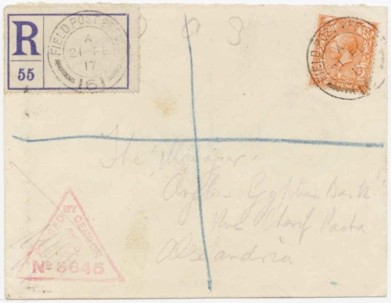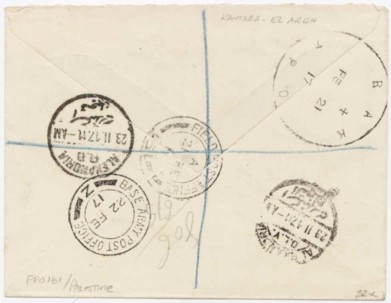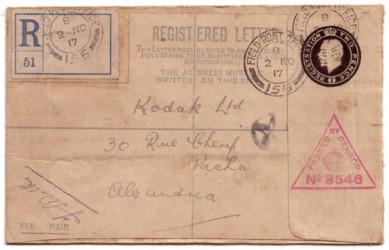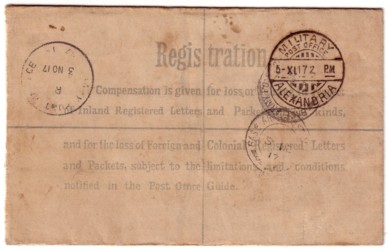|
|
The history of army and field postal services is often complicated by the constant changes of army formations and their positions.
The Egyptian Expeditionary Force and their actions on the Sinai and in Greater Syria during World War I is dealt with in the works of Michael Sacher and especially John Firebrace.
I have tried to collate the most basic facts of the field postal services in the E.E.F. from these sources, therefore the following is to a large extent merely a summary of relevant facts from the work of John Firebrace.
|
|
General
|
At no time was the Force in Egypt an Expeditionary Force and it was never served by the Army Postal Service; it was always reliant upon the Egyptian civil post office.
Troops' letters in 1914 were therefore subject to Egyptian civil rates, Egypt being a member of the U.P.U. at that time. These provisions applied to incoming Territorial troops, [...]
The postal rates were 5 mills. for a letter weighing up to 20 grammes and 4 mills. for a post card.
[...] Force in Egypt announced that arrangements had been made with the Egyptian post office to introduce [...] free postage on soldiers' letters handled by the Egyptian civil post office.
This arrangement came into being on 24 May [1915] with the proviso that mail was signed by an Officer. [...]
[...] B.A.P.O. Z. was opened on 5 April [1915]. Troops forming part of the M.E.F., therefore, had the benefit of Army Post Office facilities which included the sending of letters home postage free. [...]
[...] in March 1916, the services of the Army Post
Office were available for all troops in Egypt. The E.E.F. Army Post Offices remained open until 15 September 1920 when the Indian Army
Postal Service took over their responsibility. [...]
Indian:
In August 1914, members of the Indian Expeditionary Forces writing home to India paid the rates of postage applicable in India [letters: 1/2 anna, cards: 1/4 anna].
On 21 November, the Commander-in-Chief, India, telegraphed to the General Officer Commanding, Egypt, that "Free Postage to India had been sanctioned for all ranks [...]", mail being
handled through the Indian Army Postal Service. On 23 March 1916, Indian Field Post Offices were authorised to accept "Free" mail from British Forces writing to India, [...]
On 15 September 1920, the British Army Post Offices in Egypt closed and the privilege of free postage for soldiers' private letters was withdrawn.
Letters to India could be posted in Indian field post offices at the rate of 1 1/2 annas up to one ounce, equivalent to 1 1/2d. or 5 mills. Palestine.
All [Indian] troops in Palestine were to use Indian field post offices, letters being prepaid in Indian adhesives overprinted "I.E.F."
In order to maintain the Government's promise of November 1914, however, that letters home to India were to be postage free,
Commanding Officers were instructed to buy adhesives from field post offices for issue to the troops, correct usage being ensured.
Free postage had been extended to British personnel serving with Indian formations.
Australian:
[...] When stamps are available, all letters will be prepaid. When no stamps are available, letters will be endorsed "Stamps not available", "On Service with A.I.F."
On arrival in Egypt Australian troops came under command the Force in Egypt and therefore paid Egyptian civil rates on letters and
post cards. [...] As from 24 May 1915, letters up to 4 ounces from all Australian Forces in Egypt were sent postage free.
New Zealand:
No postage was charged on letters and post cards written by soldiers on New Zealand troopships, this being a matter purely within the jurisdiction of the New Zealand government. On landing in Egypt and joining the Force in Egypt, New Zealand troops mail arrangements followed the same Course as that for Australian troops noted above.
|
(J. Firebrace: British Empire campaigns and occupations in the Near East,
1914--1924 : a postal history, p.248--249)
|
|
|
|
Registration fees were always to be pre-paid. Initially regular British registration envelopes were used ("Registration Two Pence Postage One Penny") until special envelopes were made to provide for free postage of soldiers on active service ("Registration Two Pence"). According to Firebrace these were first printed in January 1915 but are not known to be used in the Near East until November 1915.
Indian forces used largely an Indian registration envelope ("Registration Two Annas -- Postage Half Anna"), but use of the British envelopes is apparently also common.
Registered letter, FPO D.52, 6.03.1917, arrived in London 31.03.1917. Image: Ebay.
|
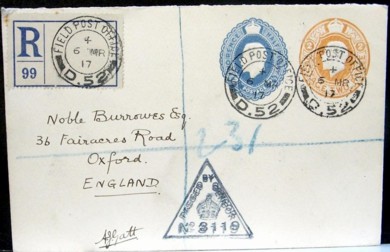
|
|
|
|
|
The armies which in the end conquered Palestine, Transjordan, Lebanon, and Syria, established a Field Post service system on an enormous scale.
This postal system of the E.E.F. was formed of British, Australian, New Zealand, and Indian sections, and served an area stretching from Mersina to Assiut and from Sollum to Amman through 140 military post offices.
The personnel of all sections totalled: British - 25 officers, 564 men; Australian - 1 officer, 57 men; New Zealand - 12 men; Indian - 18 British officers, 29 other ranks, and 257 Indian officers and other ranks.
The average number of bags received weekly for the troops from overseas reached:
| Letters | Parcels | Total
|
| British bags | 2,500 | 2,350 | 4,850 |
| Australian bags | 632 | 1,339 | 1,971 |
| New Zealand bags | 130 | 270 | 400 |
| Indian bags | 20 | 20 | 40 |
The maximum number of bags received in one calendar week at one port
amounted to 24,810. Every bag, from its dispatch to this force to its
receipt at the railhead, had to be handled and re-handled not less than 25
times.
The average number of letters sent weekly to the home countries was:
British - 500,000; Australian - 42,000; New Zealand - 8,400; Indian - 15,000.
The total number of letters for the whole period were:
British - 36,000,000; Australian - 3,000,000; New Zealand - 660,000; Indian - 950,000.
Letters received from home were received in sealed bags and amounted for the period to many millions, exceeding the above figures.
173,750 letters circulated weekly within the forces, and 47,000 letters were posted weekly by the E.E.F. for Egypt.
The combined Army Returned-Letter Offices dealt with 4,548,000 items.
Registered letters dealt with by the combined services during the period totalled 600,000 received. and. 297,000 dispatched.
|
| (E. Rachwalsky and D.F. Harrison: The postal history and postmarks of the Egyptian Expeditionary Force (E.E.F.) with special reference to Palestine. In: BAPIP Bulletin. No. 30, 1958, p.7.)
|
|
|
|
Principle Formations
|
The Egyptian Expeditionary Force was formed out of the merger of Force In Egypt (FIE, stationary British troops in Egypt) and Mediterranean Expeditionary Force (MEF, troops evacuated from the Dardanelles).
Both headquarters were moved to Ismailia in January 1916. The merger was effective from 20.03.1916. The first commander of EEF was Lt.Gen. Sir Alexander Murray.
Turkish stamp commemorating the victory of the Ottoman troops under the command of Mustafa Kemal Pascha at the Dardanelles. The stamp shows a map of the Gallipoli area and Sultan Mohammed V. (MiNr. 633, issued 5.06.1917)
|
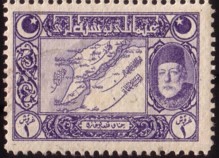
|
Mail of the FIE was handled by civilian facilities and military post offices situated at a number of barracks.
The MEF had been designated British FPO datestamps with a Z code as part of the Dardanelles Army (HQ at Imbros), ie. FPO GZ.
Upon arrival in Egypt the MEF used the new code letter M. Use of this mark (FPO GM) is known at the new HQ in Ismailia for the period 30.01.1916--19.03.1916.
The merged EEF continued the use of the FPO GM postmarks without any break on 20.03.1916. From August 1916 the newly formed echelons use postmarks FPO GM1 (1st Echelon, Palestine, 20.08.1917--7.04.1919), FPO GM2 (2nd Echelon, Cairo, 20.08.1917--16.05.1919), and FPO 3rd Echelon (Cairo, 24.04.1916--1.04.1917).
The EEF sees its first action at Qatia (23.04.1916). On 18.10.1916 Eastern Force is created; its twin division Western Force operates in the Libyan desert.
During December Eastern Force receives a new structure: On 22.12.1916 Suez Canal Defences is divided into Northern Section and Southern Section, it is joined by Desert Column (formed 7.12.1916). Its headquarter is situated at Ismailia.
Upon this reorganisation the General Headquarter of EEF moves to Cairo on 23.10.1916.
EEF troops reach Rafa on 9.01.1917. Initially the Eastern Force HQ moves to el-Arish (February 1916), then to Deir-el-Balah (28.03.1917).
On 20.03.1917 HQ of the Desert Column is moved to Khan Yunis where it is joined by the HQ of Northern Section on 2.05.1917.
On 4.04.1917 control of Southern Section had reverted to GHQ in Cairo.
At headquarters, Eastern Force uses the postmark FPO F.1. Use is known for the period 12.12.1916--6.08.1917. Desert Column uses two marks: FPO CD3 (7.12.1916--18.05.1917) and FPO HM (2.06.1917--9.08.1917).
After the appointment of a new commander, Gen. Sir Edmund Allenby, Eastern Force is disbanded (effective from 12.08.1917) to form 1st Echelon EEF.
Its GHQ is situated at Kelab (near Khan Yunis) and consists of three newly created corps: XX Corps, XXI Corps and Desert Mounted Corps (the former Desert Column).
2nd Echelon EEF and 3rd Echelon EEF remain at Cairo throughout the war.
On 20.01.1918 GHQ 1st Echelon EEF is moved to Bir Salem (near Ramleh). An advance GHQ is established at Mount Carmel (Haifa) on 26.10.1918. It gets absorbed on 9.04.1919 when the GHQ moves to Haifa.
XX Corps |
XXI Corps |
Desert Mounted Corps
|
|
Formed from Northern Section troops on 2.08.1917. HQ is at Deir-el-Balah.
The HQ is subsequently moved thus:
- 3.09.1917 Fuqari (near Rafah)
- 2.11.1917 Beersheba
- 23.11.1917 Junction Sta.
- 28.11.1917 Latrun
- 3.01.1918 Jerusalem
- 19.09.1918 Ramallah
- 24.09.1918 Nablus
- 29.10.1918 Haifa
At the end of hostilities XX Corps is withdrawn to Heliopolis (Egypt) on 6.12.1918 and gets disbanded by 21.05.1919.
|
Formed from Northern Section troops on 12.08.1917. HQ is at Deir-el-Balah.
The HQ is then moved thus:
- 3.09.1917 Fuqari (near Rafah)
- 11.11.1917 Deir Seneid
- 19.11.1917 Junction Sta.
- 28.11.1917 Bir Salem (Ramleh)
- 4.01.1918 Jaffa
- 1.04.1918 Jerishe (Nehr-el-Auja)
- 19.09.1918 Tulkarem
- 29.09.1918 Haifa
- 8.10.1918 Beirut
By December British divisions are withdrawn and on 6.05.1919 the corps moves back to Haifa, where it gets disbanded. Remaining troops are absorbed by Northforce.
|
Formed from Desert Column troops on 12.08.1917. HQ at Abasan (near Khan Yunis).
The HQ then moved thus:
- 27.10.1917 Beersheba
- 17.11.1917 Yebna (Ramleh)
- 30.04.1918 Jericho
- 25.09.1918 Tiberias
- 15.10.1918 Homs
- --.01.1919 Aleppo
On 7.06.1919 Desert Mounted Corps gets disbanded.
|
| At HQ XX Corps uses a FPO H20 postmark. Its use is known between 15.08.1917 and 30.06.1919. A second mark is used by the train section: FPO H20T (29.07.1917--31.10.1918). |
The XXI Corps HQ uses a FPO H21 postmark, known use lies between 17.08.1917 and 18.03.1919. |
At the Desert Mounted Corps HQ the postmark used by Desert Column is retained: FPO HM (11.10.1917--16.06.1919) |
|
|
|
On 27.05.1919 GHQ 1st Echelon EEF moves to Cairo and the scaled down troops are reformed: During May and June 1919 the three corps are disbanded and on 6.05.1919 Northforce is created. It comprises of four divisions remaining from XXI Corps. On 17.08.1919 it is renamed Northforce, Palestine & Syria, E.E.F., and from September operates the entire occupied territories from East of Kantara to Syria. Its HQ is at Mount Carmel (Haifa). From 1.11.1919 troops withdraw from Cilicia and Syria, and on 15.01.1920
Northforce gets dissolved.
During its existence Northforce is known to have used an FPO SZ16 postmark at its headquarter. Code letters SZ designate stationary FPO facilities.
In August 1921 Field Troops Egypt (1 division, 3 brigades, at Cairo and Alexandria) is created, in October follow Troops In Palestine (1 division, 2 brigades: North Palestine Brigade and South Palestine Brigade) and South Palestine Troops.
Field Troops Egypt gets disbanded in June 1922, followed by Troops In Palestine and South Palestine Brigade in July. In November North Palestine Brigade is dissolved and by December 1922 EEF becomes British Troops In Egypt. South Palestine Troops is disbanded in April 1923.
|
|
Indian Formations
Indian troops serve in the Near East theatre throughout the war. The first battalions of the Indian Expeditionary Forces (IEF) arrive in Egypt in November 1914 and serve on the defence of the Suez Canal.
In February 1916 the brigades are dissolved and by June 1917 Indian most battalions have left the area or joined British divisions.
In early 1918 two new divisions arrive in the Near East theatre. By 1920/1921 they become part of Troops In Palestine or get disbanded.
In April 1918 Indian troops also serve in the EEF as part of British Brigades and divisions. Indian battalions also served in Turkey and Russia.
Indian cavalry served in the EEF as part of British mounted brigades and divisions. The first Indian troops joined in May 1918 and most had left by July 1920.
The last Indian troops leave Palestine in 1923.
All Indian formations were also served by Indian Field Post Offices and their facilities. According to Firebrace, Indian FPOs used a total of 16 discernible types of datestamps, but mainly it is type IFPO1.
I have compiled a concise listing of Indian formations and their postal datestamps: Indian FPOs.
|
|
Australian and New Zealand Formations
Australian and New Zealand troops served in the Near East theatre for most of the war. The first battalions of the Australian Imperial Force and the New Zealand Expeditionary Force arrive in Egypt on 3.12.1914. Initially in transit for Europe they become Australia and New Zealand Army Corps (ANZAC) on 21.12.1914. After deployment in the Dardanelles the corps is evacuated to Egypt in December 1915 and leaves for France in April 1916. The few troops remaining in Egypt are formed into II Anzac Corps on 2.03.1916. Apart from some mounted troops, that corps also leaves for France in June 1916. Formations in Anzac Mounted Division subsequently serve in Desert Column and Desert Mounted Corps as well as in Imperial Mounted Division and
Australian Mounted Division.
By August 1919 all troops have left for Australia.
Australian and New Zealand formations were also served by dedicated Field Post Offices and their facilities. According to Firebrace several dozen types datestamps can be discerned. They include both named and coded datestamps.
I have compiled a concise listing of Australian and New Zealand formations and their postal datestamps: ANZAC FPOs.
sss
work in progress!
|
|
|
|
Registered letter to Alexandria. The British stamp is cancelled with
FIELD POST OFFICE / 161 / A / 21 FE / 17 (Sacher type D). The same mark appears on the registration label. Triangular censor handstamp PASSED BY CENSOR / No. 3645 (Sacher Cen.2, Firebrace CM3).
On the reverse we find another strike of FPO161, and this travelling PO mark R A K / T P O / + / FE 21 / 17 of the railway line built by EEF. Transit mark BASE ARMY POST OFFICE / Z / 22 FE / 17 (at Alexandria) and two Alexandria marks (R.B. and D.L.V., both dated 23.II.17.11–AM. This cover bears none of the dumb marks regularly found on military mail delivered locally in Alexandria.
161 Infantry Brigade, as part of 54 Infantry Division, was serving in the EEF advance on the Sinai and had moved to Romani on 17.01.1917. The division was involved in the first battle of Gaza (25.03.1917) and remained stationed at Gaza to November 1917.
The railhead reached Sheikh Zoward on 1.03.1917, ie. 40km East of El Arish and only 15km West of Rafah. According to Sacher this TPO worked from January to May 1917 and only westwards from the railhead (i.e. El Arish) to Kantara (RAK). Only nine covers are known.
Image: Ebay (www.mayoph.com: $225).
|
|
|
|
|
Registered letter from Gaza, most likely transporting photogaphic films to be processed at Kodak Ltd., Alexandria. Regular British military registration envelope with an imprinted 2d stamp (GD).
Datestamp: FIELD POST OFFICE / 156 / B / 2 NO / 17 (two strikes, plus additional strike on the registration label). Red triangular censor handstamp PASSED BY CENSOR / No. 3546 (Sacher Cen.2, Firebrace CM3) and officer's signature.
On the reverse three different postmarks:
ARMY POST OFFICE / SZ1[?] / R / 3 NO 17, BASE ARMY POST OFFICE / [Z] / 5 NO / 17 (at Alexandria) and
MILITARY / POST OFFICE / ALEXANDRIA / 5-XI. 17 2 PM (Firebrace A2).
The dumb mark (five-pointed semi-shaded star) denotes local delivery of military mail in Alexandra (Firebrace, p314).
156 Scottish Rifles Brigade, as part of 52 Lowland Division, can be located on 1.11.1917 in the attack on the Gaza defences ("Third Battle of Gaza").
|
|
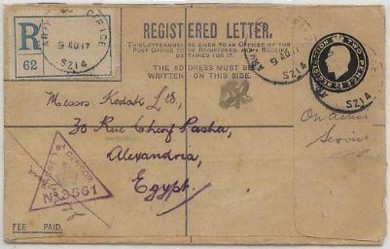
|
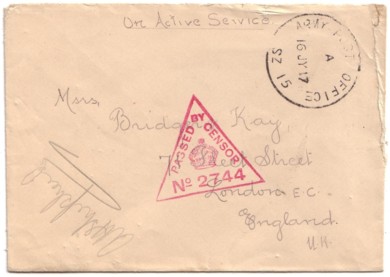
|
|
British registration envelope (2d) used "on active service" in Palestine: ARMY POST OFFICE / SZ14 / 9 AU17 (two strikes, Sacher type A), situated at Deir-el-Belah (West of Gaza) from May 1917. Same postmark on the registration label.
Triangular censor handstamp in purple: PASSED BY CENSOR / No. 3561 (Sacher Cen.2, Firebrace CM3). The dumb mark (five-pointed semi-shaded star) denotes local delivery of military mail in Alexandra (Firebrace, p314).
Image: Ebay.
|
Letter from the Sinai to London: ARMY POST OFFICE / SZ 15 / A / 16 JY 17 (Sacher type A), a stationary APO in the el-Arish area serving hospitals from November 1916 to April 1918, in Palestine L.o.C. from 26.06.1917.
Triangular censor handstamp in very fresh reddish colour: PASSED BY CENSOR / No. 2744 (Sacher Cen.2, Firebrace CM3).
|
|
|
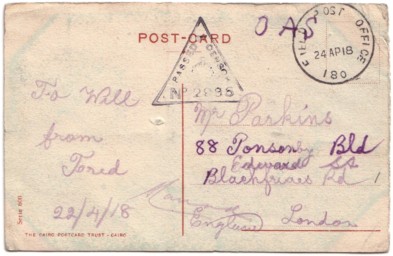
|
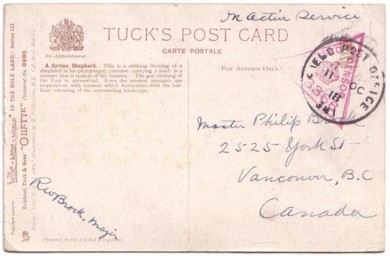
|
Picture postcard showing Avenue of the Casino, Port Said sent "OAS" from Palestine to London.
Postmark: FIELD POST OFFICE / 180 / 24AP18 (Sacher type L). The 180 Infantry Brigade (part of 60 Infantry Division) operated in the Jordan Valley and Transjordan during March and April 1918. Firebrace notes "Second Trans-Jordan Raid" for 30.04.1918.
Triangular censor handstamp in black: PASSED BY CENSOR / No. 2986 (Sacher Cen.2, Firebrace CM3).
|
Picture postcard (showing A Syrian Shepherd) sent "on active service" from Palestine to Canada.
Postmark: FIELD POST OFFICE / GM1 / 11 OC / 18 (Sacher type M) situated in Jerusalem (formerly at the GHQ in Bir Salem).
Triangular censor handstamp in purple: PASSED BY CENSOR / No. 3366 (Sacher Cen.2, Firebrace CM3).
|
|
|
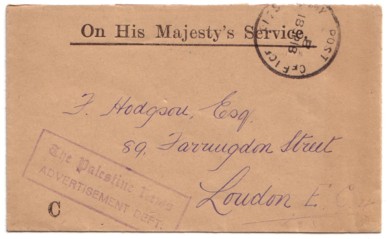
|
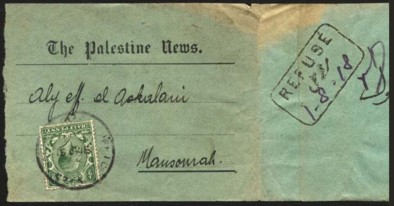
|
An official letter sent from Cairo to London. Postmark: ARMY POST OFFICE / SZ10 / B / 18SP18, the Advance Base APO in Cairo.
Official imprint "On His Majesty's Service." on top and "C" in bottom left corner.
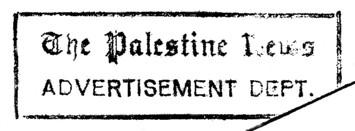
|
Additionally there is a cachet in dark purple The Palestine News / ADVERTISEMENT DEPT. (first line in gothic typeface). This is similar to government cachets referring to The Palestine News (Sacher Jerusalem 7a and 7b) used in Palestine from the start of 1918. The Palestine News existed as a weekly army newspaper from March 1917 to April 1919. Its offices (including the subscription and advertising staff) were based at 6, Midan Soliman Pasha, Cairo, where it was also printed. Therefore this letter never touched Palestine. Subscribers received the newspaper regularly via APO SZ 10: see wrapper on the right (this image courtesy of William Carson).
|
|
|
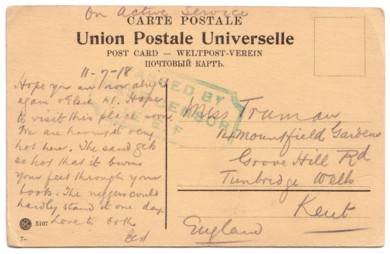
|
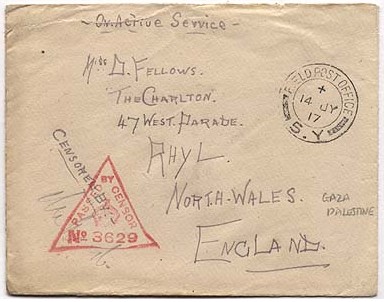
|
On this picture postcard there are no markings to prove it was ever handled by the Field Post Office system, but it bears an E.E.F. censor mark.
The picture side shows the manger (crêche) in Bethlehem, but the text says "Hope to visit this place soon." So the card was not sent from Bethlehem itself. The date is noted down as "11-7-18". Bethlehem had been captured by the E.E.F. on 8.12.1917.
The censor mark, struck here in a greenish ink, has the size of about 57x26mm: PASSED BY / BASE CENSOR / E. E. F. It is not listed by Sacher as this censor office was based in Cairo. Firebrace lists it as PBC4, in use from November 1917 to January 1919.
|
Letter from Palestine to Wales: Datestamp FIELD POST OFFICE / 5. Y / + / 14 JY / 17 assigned to 5 Mounted Brigade (consisting of Warwickshire, Worcestershire, and Gloucestershire Yeomanry battalions), at the time part of Australian Mounted Division operating in the Gaza/Rafa area.
Triangular censor handstamp in red: PASSED BY CENSOR / No. 3629 (Sacher Cen.2, Firebrace CM3) and manuscript "CENSORED BY:" and censor's signature.
Image: Ebay.
|
|
|
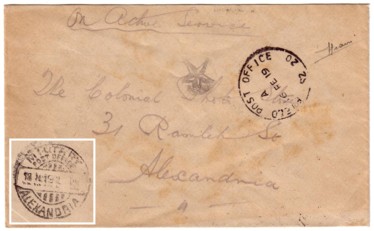
|
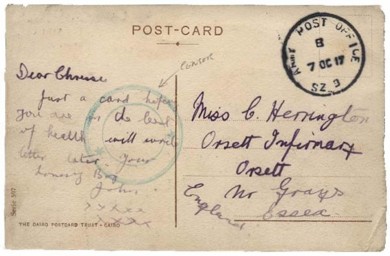
|
|
Letter sent "On Active Service" from Palestine to Alexandria:
Military datestamp FIELD POST OFFICE / SZ 20 / A / 16 FE 19, assigned to a stationary post office in Palestine Line Of Communications at Ludd. On reverse transit mark MILITARY / POST OFFICE / ALEXANDRIA / 18 II 19 2 PM (Firebrace A2) and arrival mark ALEXANDRIA / V / 18. II. 19 3 - P. The dumb mark (five-pointed semi-shaded star) denotes local delivery of military mail in Alexandra (Firebrace, p314).
|
Post card from Palestine to England: Datestamp ARMY POST OFFICE / SZ 9 / B / 7 OC 17, a stationary (advance base) office in Palestine Line of Communications at Rafa. The dumb censor mark (a triple circle with two stars struck in green, Firebrace DM11) is only known used between October 1917 and January 1918 and together with the APO SZ9 postmark.
Image: Ebay.
|
|
|
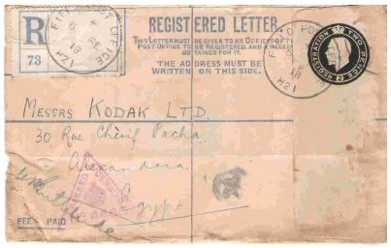
|
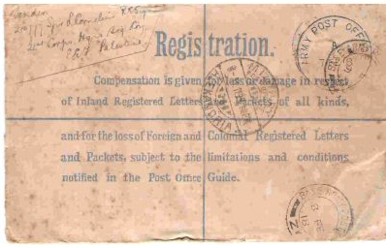
|
British registration envelope, specially produced for personnel on active service, sent from Palestine to Alexandria with the datestamp of XXI Corps headquarter at Jaffa:
FIELD POST OFFICE / H21 / [+] / 6 FE / 18, cancelling the 2d registration fee stamp and localizing the blank registration label.
On reverse two transit marks:
ARMY POST OFFICE / ... / A / 7 FE 18 and
BASE ARMY POST OFFICE / Z / 8 FE / 18 (Alexandria BAPO), and arrival marking
MILITARY / POST OFFICE / ALEXANDRIA / ... (Firebrace A2). No civilian Alexandria marking.
The dumb mark on the front is, though not listed, remotely similar to types DM7 or DM13, denoting local delivery of military mail in Alexandria (Firebrace, p314).
Triangular censor handstamp in red: PASSED BY CENSOR / No. 4465 (Sacher Cen.2, Firebrace CM3)
Image: Ebay.
|
|
|
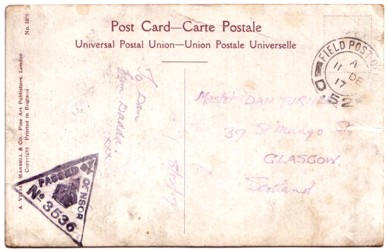
|
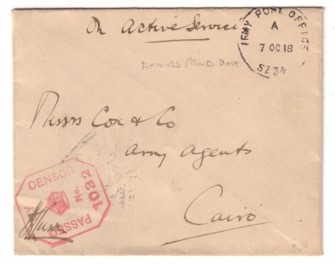
|
Picture postcard dated "8/12/17", sent from Palestine to Scotland. Postmark FIELD POST OFFICE / D.52 / A / 11 DE / 17, the datestamp used at divisional HQ of 52 Lowland Division (part of XXI Corps), at the time situated in the Jaffa area. Firebrace notes the battle of Jaffa for exactly this date: 11.12.1917.
Triangular censor handstamp in black: PASSED BY CENSOR / No. 3536 (Sacher Cen.2, Firebrace CM3)
|
Small-sized letter sent "on active service" from Palestine to Cox & Co., Army Agents, in Cairo. Postmarked ARMY POST OFFICE / SZ 34 / 7 OC 18, indicating use at a stationary office in Jaffa which was reportedly used mainly by Italian troops. Red censor mark PASSED / BY / CENSOR / No. / 1032 (Firebrace CM7) accompanied by an officer's signature. Cairo arrival mark on back.
|
|
|
|
|
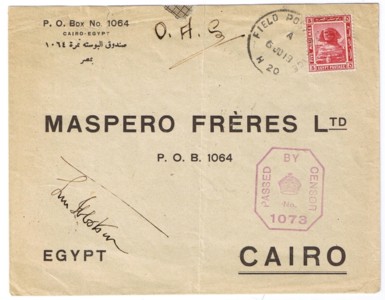
|
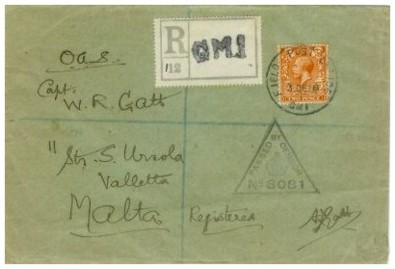
|
Letter, despite being marked "O.A.S.", franked with a regular Egyptian 5m definitve. Postmark: FIELD POST OFFICE / H 20 / A / 6 JU 18.
XX. Corps HQ was situated near Jeruselem at the time.
Violet censor mark PASSED / BY / CENSOR / No. / 1073 (Firebrace CM7) accompanied by an officer's signature to the left.
On reverese arrival mark CAIRO / B / -7.VI.18.6 00PM.
Owner Simon Smelt remarks: "It follows that this is an odd example of use of an Egyptian postage stamp in Palestine by the EEF.
As the envelope is pre-addressed, maybe the stamp was
pre-affixed as well. Possibly, the officer's signature is to OK
the usage."
Image: Simon Smelt.
|
Registered letter, OAS, sent from EEF HQ to Malta. Postmark: FIELD POST OFFICE / GM 1 / 3 DEC 18.
Triangular censor handstamp in black: PASSED BY CENSOR / No. 3031 (Sacher Cen.2, Firebrace CM3).
R-label GM1 with manually corrected "112".
Image: Ebay.
|
|
|


